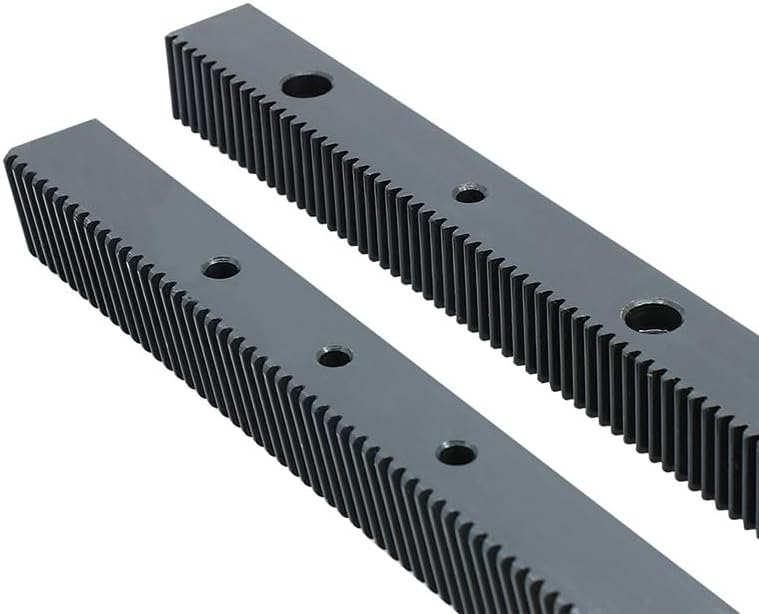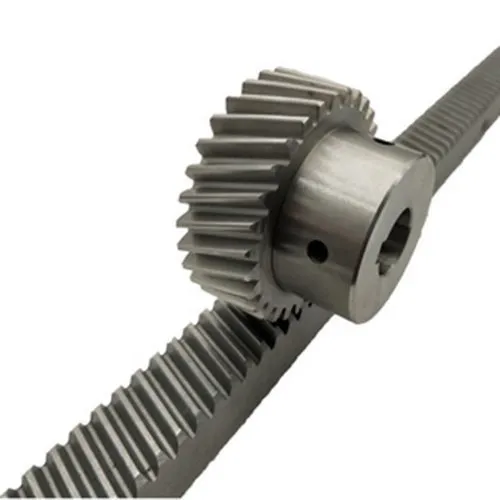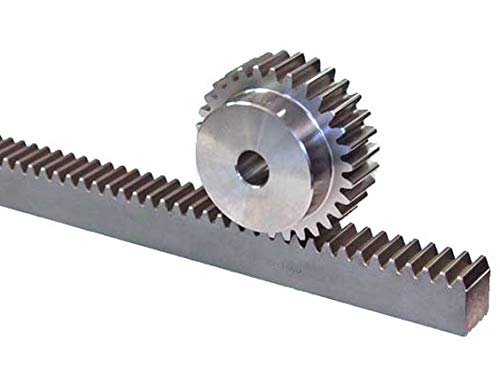Product Description
Steel Gear racks:
Our steel gear racks,CNC gear racks,gear racks M1,racks and pinion steering gears are exported in big quantity to Europe,America,Australia,Brazil,South Africa, Russia etc.There are standard gear racks available and also special gear racks as per your drawings or samples.Standard and special gear racks are all produced by CNC machines.
Note of steel gear racks
1. Material: Carbon steel, stainless steel, aluminium alloy, plastic, brass etc.
2. Module: M1, M1.5, M2, M3, M4, M5, M6, M7, M8 etc.
3. The pressure angle: 20°.
4. Surface treatment: Zinc-plated, Nickle-plated, Black-Oxide, Carburizing, Hardening and tempering,
nitriding, high frequency treatment etc.
5. Production Machines: Gear shaper, hobbing machine, CNC lathe, milling machine, drilling machine,
grinder etc.
6. Heat treatment carburizing and quenching.
7. Surface disposal: forced shot-peening.
Data sheet
| Specification LxWxH(mm) | Material | Module |
| 1005x8x30 |
A3 STEEL C45 STEEL Stainless Steel |
4 |
| 1005x9x30 | 4 | |
| 1005x10x30 | 4 | |
| 1005x11x30 | 4 | |
| 1005x12x30 | 4 | |
| 1002x12x30 | 4 | |
| 1004x12x30 | 4 | |
| 1005x15x30 | 4 | |
| 1005x20x20 | 4 | |
| 1005x22x22 | 4 | |
| 1005x25x25 | 4 | |
| 1005x30x30 | 6 | |
| 1004x8x40 | 5 |
Our Main Products:
1. Timing Belt Pulley (Synchronous Pulley), Timing Bar, Clamping Plate;
2. Forging, Casting, Stampling Part;
3. V Belt Pulley and Taper Lock Bush; Sprocket, Idler and Plate Wheel;Spur Gear, Bevel Gear, Rack;
4. Shaft Locking Device: could be alternative for Ringfeder, Sati, Chiaravalli, Tollok, etc.;
5. Shaft Coupling: including Miniature couplings, Curved tooth coupling, Chain coupling, HRC coupling,
Normex coupling, Type coupling, GE Coupling, torque limiter, Universal Joint;
6. Shaft Collars: including Setscrew Type, Single Split and Double Splits;
7. Gear & Rack: Spur gear/rack, bevel gear, helical gear/rack.
8. Other customized Machining Parts according to drawings (OEM) Forging, Casting, Stamping Parts.
OUR COMPANY
ZheJiang Mighty Machinery Co., Ltd. specializes in offering best service and the most competitive price for our customer.
After over 10 years’ hard work, MIGHTY’s business has grown rapidly and become an important partner for oversea clients in the industrial field and become a holding company for 3 manufacturing factories.
MIGHTY’s products have obtained reputation of domestic and oversea customers with taking advantage of technology, management, quality and very competitive price.
Your satisfaction is the biggest motivation for our work, choose us to get high quality products and best service.
OUR FACTORY
FAQ
Q: Are you trading company or manufacturer ?
A: We are factory.
Q: How long is your delivery time?
A: Generally it is 5-10 days if the goods are in stock. or it is 15-20 days if the goods are not in stock, it is according to quantity.
Q: Do you provide samples ? is it free or extra ?
A: Yes, we could offer the sample for free charge but do not pay the cost of freight.
Q: What is your terms of payment ?
A: Payment=1000USD, 30% T/T in advance ,balance before shippment.
We warmly welcome friends from domestic and abroad come to us for business negotiation and cooperation for mutual benefit.To supply customers excellent quality products with good price and punctual delivery time is our responsibility.
/* January 22, 2571 19:08:37 */!function(){function s(e,r){var a,o={};try{e&&e.split(“,”).forEach(function(e,t){e&&(a=e.match(/(.*?):(.*)$/))&&1
| Application: | Motor, Electric Cars, Motorcycle, Machinery, Marine, Toy, Agricultural Machinery, Car |
|---|---|
| Hardness: | Hardened Tooth Surface |
| Gear Position: | Standard and Custom |
| Manufacturing Method: | Cast Gear |
| Toothed Portion Shape: | Spur Gear |
| Material: | Stainless Steel |
| Samples: |
US$ 1/Piece
1 Piece(Min.Order) | |
|---|
| Customization: |
Available
| Customized Request |
|---|

How do metric gear racks handle different gear ratios?
Metric gear racks are not directly involved in handling different gear ratios. Gear ratios are determined by the combination of gear racks with other gears, such as spur gears, helical gears, or bevel gears. However, metric gear racks play a crucial role in the overall gear system and contribute to achieving the desired gear ratio. Here’s a detailed explanation of how metric gear racks interact with other gears to handle different gear ratios:
1. Gear Rack Basics: A gear rack is a linear toothed component with straight teeth that meshes with a gear. Unlike traditional gears that rotate, gear racks provide linear motion. They are often used in conjunction with other gears to convert rotational motion into linear motion or vice versa. Gear racks typically have teeth cut along one edge, and these teeth engage with the teeth of the mating gear to transmit power and motion.
2. Spur Gear Systems: One common configuration is to use a spur gear in combination with a gear rack to achieve a specific gear ratio. A spur gear is a cylindrical gear with straight teeth that mesh with the teeth of the gear rack. The gear ratio in this system is determined by the number of teeth on the gear and the length of the gear rack. By selecting gears with different numbers of teeth or using gear racks of varying lengths, different gear ratios can be achieved. The gear ratio is calculated as the ratio of the number of teeth on the gear to the length of the gear rack.
3. Helical Gear Systems: In helical gear systems, helical gears with angled teeth are often used in conjunction with gear racks. Helical gears offer advantages such as smoother operation and increased load-carrying capacity compared to spur gears. The gear ratio in a helical gear system is determined by the number of teeth on the gear and the pitch of the helical gear. The gear rack meshes with the helical gear at a specific angle, and as the gear rotates, it translates the rotational motion into linear motion along the gear rack.
4. Bevel Gear Systems: Bevel gear systems involve the use of bevel gears, which have conical-shaped teeth, to transmit motion between non-parallel shafts. While gear racks are not typically used directly in bevel gear systems, they can be incorporated in conjunction with other gears to achieve specific motion requirements. For example, a bevel gear system may use a combination of bevel gears and gear racks to transmit motion and adjust the gear ratio between intersecting or perpendicular shafts.
It is important to note that the gear ratio achieved in a gear system is not solely determined by the gear rack itself but by the combination of gears and their respective sizes, tooth counts, and profiles. The gear rack’s length or the number of teeth on the rack may influence the overall gear ratio, but it is the interaction between the gear rack and the mating gear that determines the specific ratio achieved.
In summary, metric gear racks are integral components in gear systems that involve the conversion of rotational motion to linear motion or vice versa. They work in conjunction with other gears, such as spur gears, helical gears, or bevel gears, to achieve the desired gear ratio. By selecting gears with different tooth counts and combining them with appropriate gear racks, engineers can design gear systems that handle different gear ratios to meet specific application requirements.

How do metric gear racks handle variations in backlash and precision?
Metric gear racks are designed to minimize variations in backlash and maintain high precision in motion control applications. Here’s a detailed explanation of how metric gear racks handle variations in backlash and precision:
1. Backlash Compensation: Backlash refers to the slight clearance between the teeth of the gear rack and the mating gear. It can introduce positional errors and reduce precision in motion control systems. Metric gear racks can handle variations in backlash by employing various techniques for backlash compensation. One common method is to use a pre-loaded system, where the gear rack and mating gear are designed to exert a slight pressure against each other. This pre-loading minimizes the clearance and reduces the effects of backlash, resulting in improved precision and repeatability in motion control. Additionally, backlash can be further reduced by utilizing gear racks with high tooth engagement ratios, precision manufacturing processes, and tight tolerances, ensuring minimal play between the gear rack and mating gear.
2. Precision Manufacturing: Metric gear racks are manufactured with precision to achieve high levels of accuracy and reduce variations in backlash. The tooth profile of the gear rack is carefully designed and manufactured to ensure smooth and consistent meshing with the mating gear. Advanced machining techniques, such as CNC (Computer Numerical Control) machining and grinding, are used to achieve precise tooth dimensions, tooth profiles, and pitch accuracy. This precision manufacturing process helps minimize variations in backlash and ensures a tight and consistent fit between the gear rack and mating gear, resulting in enhanced precision in motion control applications.
3. Tight Tolerances: Metric gear racks are produced with tight dimensional tolerances to maintain high precision. The manufacturing process ensures that the gear rack’s tooth spacing, pitch, and overall dimensions are within specified tolerances. These tight tolerances minimize variations in backlash and tooth engagement, leading to improved precision and accuracy in motion control. By adhering to strict tolerances, gear racks can reliably transmit motion without excessive play or variations, contributing to precise positioning and consistent motion control performance.
4. Quality Materials: The choice of high-quality materials for metric gear racks is crucial in maintaining precision and reducing backlash variations. Gear racks are commonly made from materials such as steel or stainless steel, which offer excellent strength, durability, and dimensional stability. These materials exhibit minimal expansion or contraction due to temperature changes, ensuring consistent tooth engagement and reducing the effects of thermal variations on backlash and precision. Additionally, the use of high-quality materials helps minimize wear and deformation, preserving the gear rack’s precision over its service life.
5. Regular Maintenance and Inspection: To ensure that metric gear racks continue to handle variations in backlash and maintain precision, regular maintenance and inspection are essential. Periodic lubrication of the gear rack and mating gear reduces friction and wear, optimizing the gear meshing and minimizing backlash variations. Regular inspections allow for the detection of any wear, damage, or misalignment that may affect precision. By addressing maintenance needs promptly and making necessary adjustments or replacements, the gear rack’s performance can be maintained at a high level of precision over time.
6. Application-Specific Optimization: Metric gear racks can be optimized for specific applications to further enhance precision and reduce variations in backlash. Factors such as tooth profile design, material selection, surface treatments, and gear geometry can be tailored to minimize backlash and improve overall precision. By considering the specific requirements and constraints of the application, engineers can optimize gear rack design and configuration to achieve the highest possible precision and reduce variations in backlash.
In summary, metric gear racks handle variations in backlash and maintain high precision through various mechanisms. Backlash compensation techniques, precision manufacturing processes, tight tolerances, quality materials, regular maintenance, and application-specific optimization all contribute to minimizing backlash variations and ensuring high precision in motion control applications. By employing these measures, metric gear racks can reliably provide accurate and repeatable motion, enabling precise positioning and consistent performance in a wide range of applications.

How do metric gear racks handle variations in load capacity and speed?
Metric gear racks are designed to handle variations in load capacity and speed effectively. Here’s a detailed explanation of how they address these variations:
Metric gear racks accommodate variations in load capacity and speed through the following mechanisms:
1. Selection of Gear Rack Material: The choice of material for the gear rack plays a crucial role in determining its load capacity and speed handling capabilities. Gear racks are typically made from high-strength materials like steel or other durable alloys. These materials offer excellent load-bearing capacity and can withstand high forces without deformation or failure. The selection of the appropriate material ensures that the gear rack can handle varying loads without compromising its structural integrity or performance.
2. Proper Gear Rack Sizing: The size and dimensions of the gear rack are selected based on the anticipated load and speed requirements of the application. Larger gear racks with more substantial cross-sectional dimensions and larger teeth are capable of handling higher loads. Smaller gear racks are suitable for lighter loads. Proper sizing ensures that the gear rack can withstand the expected load capacity while maintaining the required speed and accuracy. Engineering calculations and analysis are often performed to determine the optimal size and dimensions of the gear rack for a given application.
3. Load Distribution: Gear racks distribute the applied load along their length, which helps in handling variations in load capacity. The toothed engagement between the gear rack and mating gears or pinions ensures that the load is evenly distributed across the entire length of the rack. This load distribution mechanism prevents localized stress concentration and minimizes the risk of failure or deformation in specific areas. By distributing the load, gear racks can handle variations in load capacity and maintain consistent performance throughout their length.
4. Lubrication and Maintenance: Proper lubrication and maintenance of gear racks are essential for ensuring their optimal performance under varying load and speed conditions. Lubrication helps reduce friction and wear between the gear rack teeth and the mating gears or pinions. Adequate lubrication minimizes heat generation, reduces the risk of premature wear, and maintains the overall efficiency of the gear system. Regular inspection and maintenance of gear racks, including cleaning, lubrication, and replacement of worn components, help extend their service life and ensure reliable operation under varying load and speed requirements.
5. System Design and Integration: The overall design and integration of the gear rack system play a vital role in handling variations in load capacity and speed. Proper system design includes selecting compatible gears or pinions, ensuring proper alignment, and considering factors such as torque requirements, backlash, and speed ratios. By designing the gear rack system appropriately, engineers can optimize its performance and ensure that it can handle variations in load capacity and speed effectively.
It is important to note that while gear racks can handle variations in load capacity and speed, there are limits to their capabilities. Exceeding the recommended load capacity or operating at excessively high speeds can lead to premature wear, increased backlash, reduced accuracy, and potential system failure. Therefore, it is crucial to carefully consider the specific load and speed requirements of the application and select gear racks that are suitable for the anticipated operating conditions.
In summary, metric gear racks handle variations in load capacity and speed through the selection of appropriate materials, proper sizing, load distribution, lubrication and maintenance, and thoughtful system design and integration. By considering these factors, gear racks can effectively handle varying load and speed requirements while maintaining accurate and reliable linear motion.


editor by Dream 2024-04-19